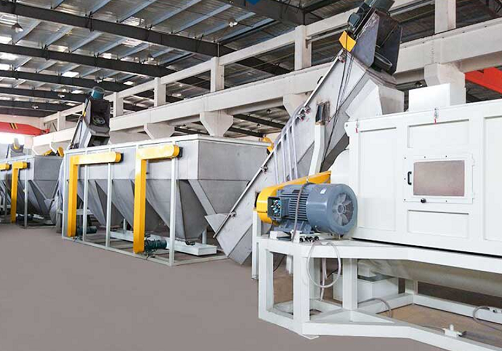© 2018 Zhangjiagang Sevenstars Machinery Co.,Ltd. All rights reserved. Site Map Designed by iwonder.cn privacy policy
Plastic recycling machine factory with 15 years experience
Plastic recycling machine factory with 15 years experience
Plastic materials usually need to be cut into smaller sizes in order to allow further processing and to provide easier packaging, transportation, and distribution of recycled stock. This cutting presents certain challenges, as many plastics are abrasive to metal blades and can have wide variation in their hardness, weight, and thickness. Most standard size reduction is performed by single or multi-shaft shredders, and granulators. Multi-shaft shredders perform scissor-like cutting with a series of rotating blades that can handle moderately dirty or contaminated material, but are somewhat imprecise in the size of the cuts. Single shaft shredders perform more of a tearing motion, and have slower motors that lengthen blade lifespan. They can also handle dirty or abrasive material and usually have adjustable or replaceable blades.
Granulators are composed of a rotor attached to blades that rotate within a chamber containing a grid floor. Their capacity for processing plastic material depends on the speed of the rotor, angle of the cutting blades, spacing of the grid, and the shape of the rotor. Granulators are usually sturdy machines, capable of relatively rapid cutting rates, and the presence of the grid allows for more precise control over the size of cuts. Granulator blades typically need to be replaced regularly over the course of operations.
After the plastic has been cut into smaller pieces, or “flakes,” the stock usually needs to be washed in order to remove lingering dirt or attachments. Paper, glue, sand, and grit are some of the common elements targeted in the washing process, which can be accomplished using water baths, friction washers, or a washing line. The washing line applies a continuous hot spray over a stream of plastic material, removing some or all of the labels and dirt attached to the plastic surface. Detergents and disinfecting agents are often included in this process to improve the level of cleaning.

To reduce the potential for stock contamination most recycled plastic undergoes separation treatments, which work to remove any attachments or non-reusable materials that may be present in a batch of flakes. Most separation processes can be categorized as “wet” or “dry” methods. Float tanks are the most common wet method, separating material based on density and whether it sinks or floats, while hydrocyclones use centrifugal force to divide material according to weight.
Among dry methods, air classification differentiates between types of plastic based on the ratio of flake surface area to mass, meaning thicker materials are sifted away from thin ones. Mechanical separators usually divide flakes according to size, and sometimes shape. These machines can be designed with flat, circular, or inclined configurations. Laser spectral analyzers are most advanced machines that use spectroscopic detection to determine precise levels of contamination in a given batch. Alternative devices can employ ultraviolet or fluorescent light to separate plastic according to color or light absorption levels. Melt separation machines move plastic flakes along a conveyor or hot roller while heat is applied to separate material according to melting point.
Pelletizing reclaimed plastic is the final step in most recycling processes. Converting post-consumer plastic into pellets allows for easier distribution and remanufacturing, and ultimately benefits the speed and effectiveness of reintroducing recycled plastic into industrial manufacturing. After sorting, drawing, separating, and drying the reclaimed material, the flake stock is ready to be extruded into pellets.
Typically, single or double screw extruders are used at this stage. The ratio between the length of the extruder screw and its diameter, as well overall screw design, can vary depending on the type of resin being processed. Single screw extruders rely on pumping action and shear to shape plastic, while double screw extruders perform more of a mixing function with lower shearing force to create a compound material. Ventilation and vacuum pumps may be required to regulate the degassing effects. Once the reclaimed plastic has been pelletized, it is ready for distribution and remanufacturing.
If you are interested in our plastic recycling machine, please do not hesitate to contact us!